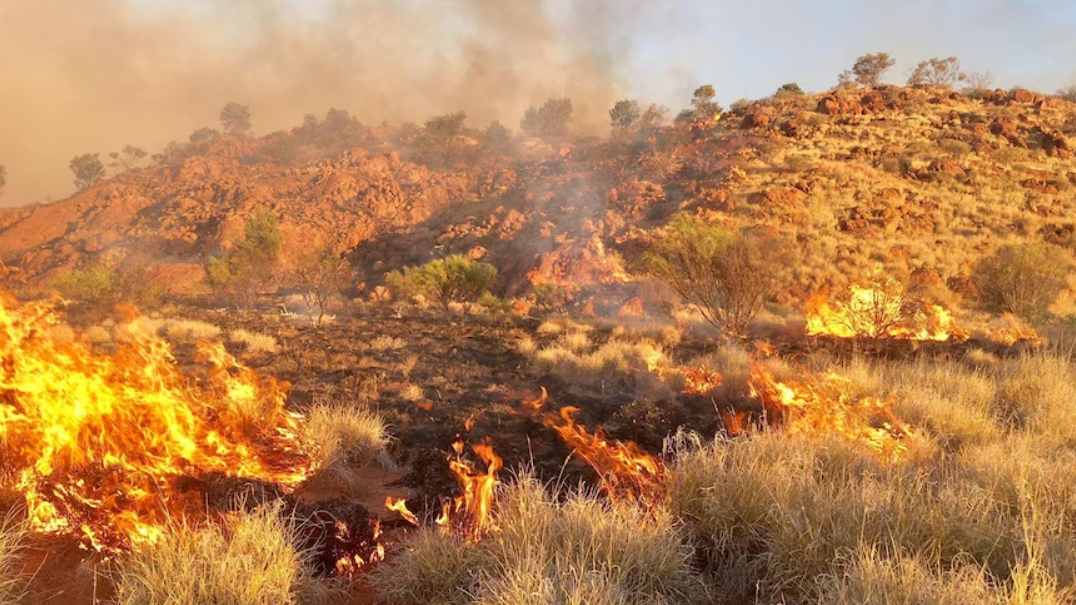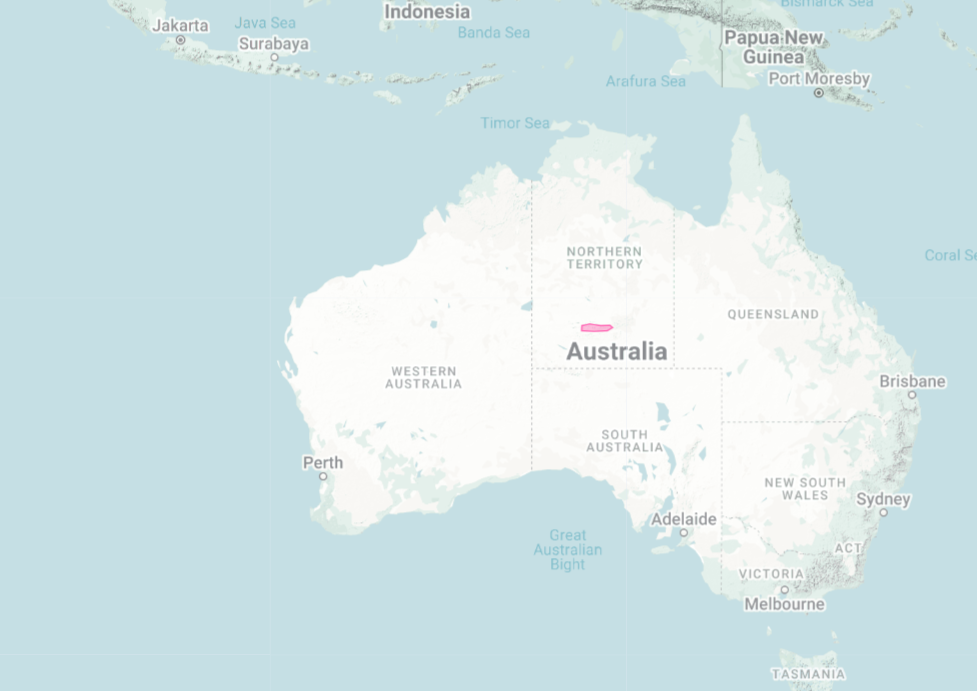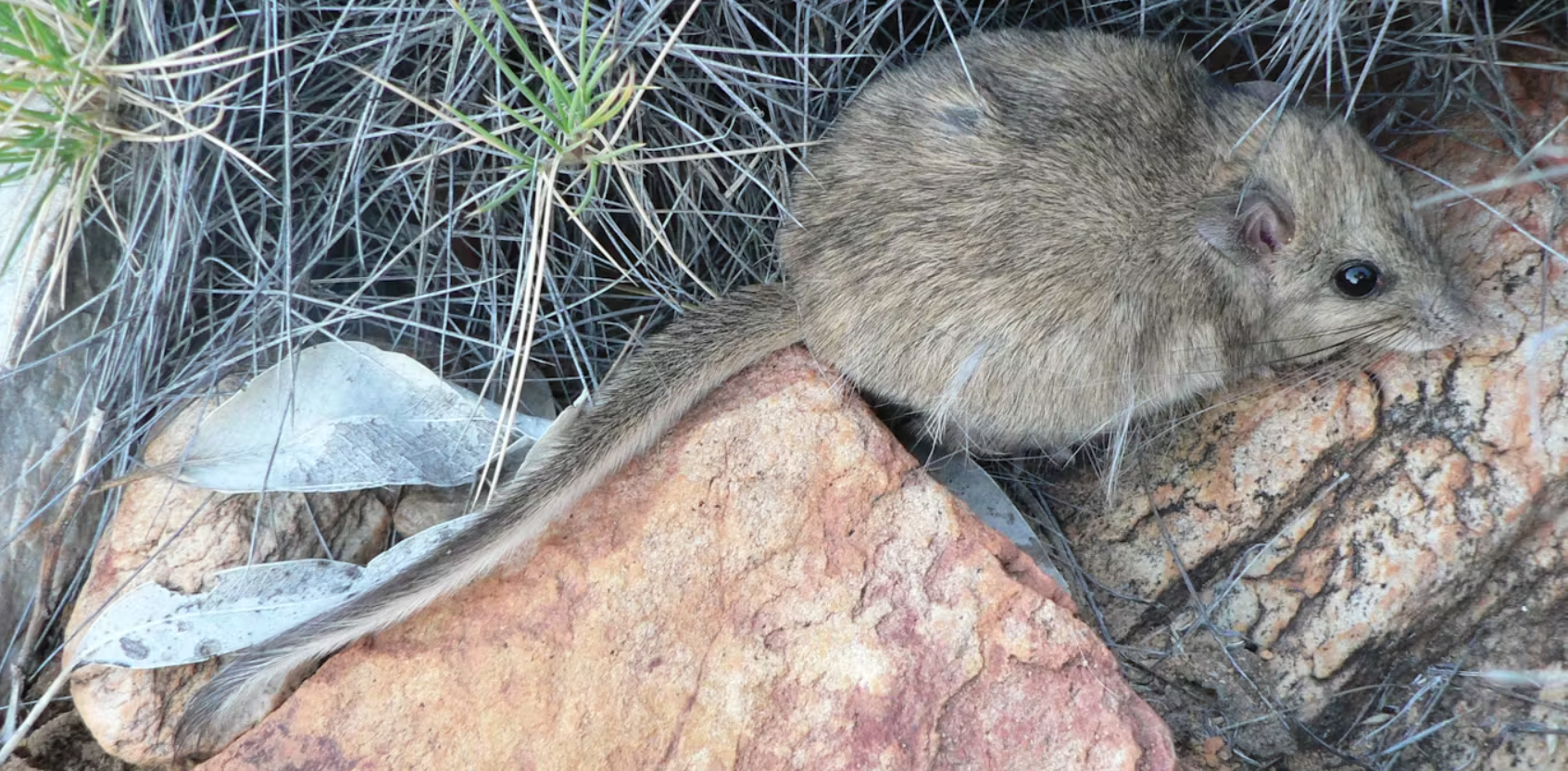Central Rock-Rat
Zyzomys pedunculatus
The central rock rat lives in central Australia around and among rocks — sheltering in crevices during days that can reach a blistering 50°C (122°F). Threatened by bushfires and invasive predators, its range has shrunk by around 95%.
The Flammable Land
Australia is the most fire-prone country in the world. The country's interior — its Outback — is a sun-scorched land of red deserts, rocky escarpments and spinifex grasslands, where long droughts are followed by sudden flash floods, followed by more droughts. Then a lightning strike or stray spark sets it all ablaze, the roaring wildfire jumping from dry clumps of grass to stands of highly flammable eucalyptus, which explode in great walls of fire. The flames eventually subside, leaving behind an ashen black, but rich earth from which the seeds of spinifex and eucalypts sprout anew. Cycles of fire have long been the regime of the Outback.
Fire-adapted plants like spinifex store their seeds in the ground, sheltered from the flames, which germinate following a blaze. But what about the Outback's fauna? How do its creatures survive the raging fires that turn their world to ash? Are there even any animals out here? Only the hardiest — although they might not look it at first glance.
The Rock Rat
The central rock rat looks like your average rat with some mousy features thrown in. Compared to a rat, it has a shorter, slightly bent snout and larger eyes, giving it a more babyish appearance. It's also daintier, only some 14 centimetres (5.5 in) long, and wears a fluffy coat of soft sandy-brown fur, and its tail, unlike the scaly nude tail of a city rat or house mouse, is covered in dense fur. It combines the best elements of a rat and mouse — and, I dare say, improves upon them.
This adorable rodent is also an adept desert survivalist. The central rock rat's name accurately describes its home; it lives in central Australia around and among rocks. In the Outback, Daytime summer temperatures can reach a blistering 50°C (122°F), and any creature not looking to be cooked stays out of the sun. The rock rat lounges in cool (or at least cooler) rock crevices during the day and creeps out at night to forage among dry tussocks for seeds, leaves, and insects. Its key to survival is proper timing, and not only when it comes to foraging.
A drought is not a good time for raising children; resources are scant, and each rock rat must focus on getting by themselves. This is the so-called 'bust' phase — the rats huddle into small areas of refuge, few if any pups are born, and the population dwindles. Then comes a sudden deluge, the rain causing an increase in resources, and the rock rat population 'booms' as each female produces litters of 1–4 pups. But the dry conditions soon return, a kind of crucible for the youngsters. Only the hardiest survive to breed when the rains fall again.
A Broken Regime
A bushfire rages across the Outback. Red kangaroos and emus flee the flames, mighty feet thumping, dashing frantically across the sand. Green night parrots take off as their scrubby shelters burst into flames. Spinifex hopping mice, rabbit-like bilbies, and sand goannas hide in burrows beneath the ground as the world burns above them. Rock rats huddle in their rocky crevices.
Once the blaze has settled, the Outback creatures emerge to find their homes blackened and barren. The burnt vegetation will regenerate, as it always has, but it will take time. Depending on rainfall, grasses and shrubs may begin to return in the first month after a fire and can become prolific once more within a year. Some plants take longer, with spinifex, for instance, taking 2 to 3 years to return if rainfall is high, but if it's not, this desert grass can take as long as 15 years.
In the interim period, as the plant life gradually returns, the rock rats struggle to find anything food and are forced to higher altitudes, atop rugged quartzite outcrops up to 950 metres (3,100 ft) tall, crowded into areas where fires haven't ravaged the vegetation. But it's not a single burning that's the problem; bushfires are a natural feature of the Outback, and vegetation is often richer once it's regrown than it was before being burned. The plants need enough time between fires, however, and they're not getting it. The warming global climate has turned the already arid Outback into a tinderbox with hotter heatwaves and longer droughts. More and more frequently, one fire after another scorches the land.
Holding Ground
On a map, the central rock rat's range — the area in which the entire species lives — appears like a tiny smudge in the centre of Australia. Before the arrival of Europeans in the 18th century, this tiny smudge would have been a broad swath that covered much of Central Australia. The rock rat's population dwindled, its range shrank, and, after a last sighting in 1960, the species appeared to go extinct. In 1996, nearly 30 years later, a small population was found within Tjoritja / West MacDonnell National Park — its range only covering 5% of what it once did.
Increasingly intense and frequent bushfires have hemmed in the central rock rat, turning 95% of its former home into unlivable habitat lacking in food and, perhaps just as importantly, cover. Fire "eats" its way across a landscape, the flames "consume" bushes and trees with an insatiable "appetite" — we often personify the unmotivated actions of this destructive force, but fire doesn't seek to kill in the same way a living predator does. Feral cats and wild foxes are not a natural part of Australia's fauna. They are the result of a human-wrought invasion, and their consequence is a mass decline in native species. Australian mammals, such as the central rock rat, didn't evolve to survive these unrelenting hunters, and with their hiding spots burnt away, they stand no chance.
That being said, central rock rats continue to exist in the harshest of environments to this day. Their population isn't large — in fact, it's tiny, comprised of around 800 mature individuals — but they persist. And these rock rats have recently been spotted crawling out of cracks and crevices across the Northern Territory.¹ They're also receiving much-needed assistance. From a breeding facility in the town of Alice Springs, 74 central rock rats were helicoptered over to the Newhaven Wildlife Sanctuary, a fenced-in area free of cats and foxes where the rock rats can thrive. Another 16 individuals were released in Alice Springs Desert Park. The species is still in dire straits — considered 'critically endangered' by the IUCN — with bushfires predicted to worsen under the effects of climate change and invasive predators. But if a few populations can persist — safe from wildfires atop their last mountainous bastions, insulated from predators in protected sanctuaries — perhaps, in some brighter future, central rock rats might scutter across the rocks of central Australia again.
If you want to contribute to the central rock rat’s survival (as well as the survival of other at-risk Australian species), you can donate to the Australian Wildlife Conservancy here!
¹ They've been recorded on camera traps 70 kilometres to the west of the known populations in Tjoritja / West MacDonnell National Park in 2013 and 100 kilometres north-west of Alice Springs at a remote cattle station in 2024.
Where Does It Live?
⛰️ Rocky outcrops, hilly grasslands, and open shrub- and woodlands.
📍 Central Australia (southern Northern Territory).
‘Critically Endangered’ as of 20 Jul, 2015.
-
Size // Small
Length // 14 cm (5.5 in) + 14 cm (5.5 in) tail
Weight // 70 - 150 g (2.5 - 5.3 oz)
-
Activity: Nocturnal 🌙
Lifestyle: Solitary 👤
Lifespan: ~7 years (max in captivity)
Diet: Omnivore (mostly herbivorous)
Favourite Food: Seeds (72% of its diet) 🌰
-
Class: Mammalia
Order: Rodentia
Family: Muridae
Genus: Zyzomys
Species: Z. pedunculatus
-
Looking like a mix of your typical rat and mouse, the central rock rat is only about 14 centimetres (5.5 in) long and has a tail covered in dense fur.
This rat follows a 'boom-and-bust' strategy of reproduction, going from pretty much celibate during a drought to exceedingly libidinous in the rain — each female producing litters of 1 to 4 pups.
Bushfires, although a natural part of the Australian Outback, have become more and more frequent, burning away vegetation before it can grow back — spinifex, for instance, takes 2 to 3 years to return if rainfall is high, but if it's not, this desert grass can take as long as 15 years.
With fires burning the rock rats' food supply (seeds, leaves, and insects), the rats are forced to higher altitudes, onto rugged outcrops up to 950 metres (3,100 ft) tall, that fires haven't ravaged. Bushfires also burn away shelter, leaving these rats exposed to invasive predators like feral cats and red foxes.
Since the arrival of Europeans in the 18th century, the rock rat's range has shrunk by some 95%, and the species is now considered critically endangered — with an estimated 800 mature individuals surviving in the wild.
-
Australian Wildlife Conservancy
Department of Climate Change, Energy, the Environment and Water
Department of Climate Change, Energy, the Environment and Water
Australian Government - Department of the Environment and Energy
Threatened Species Scientific Committee
ABC News – Spinifex grass seeding experiments post-fire
Biodiversity Conservation Trust (BCT) – Vegetation recovery in bushfire-affected areas
Department of Primary Industries and Regional Development, Western Australia – Spinifex pastures, fire resilience, and rangeland ecology in Western Australia
WWF Australia – Australian bushfires and their environmental impact
ABC News – Outback bushfire burns extensive remote areas in South Australia and Northern Territory
-










